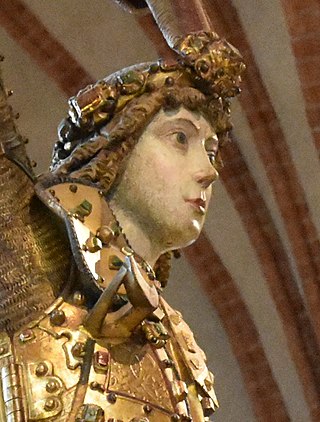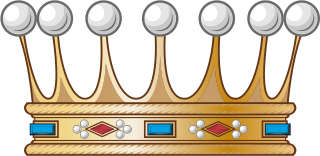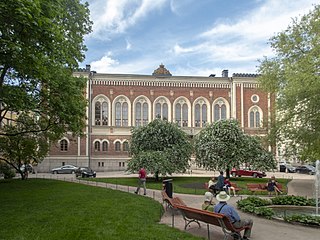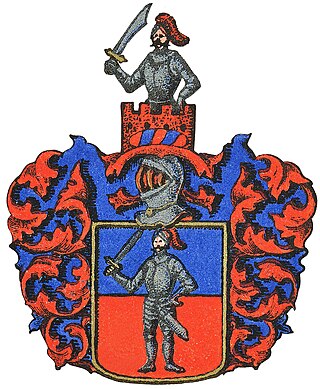
Riksdag of the Estates was the name used for the Estates of Sweden when they were assembled. Until its dissolution in 1866, the institution was the highest authority in Sweden next to the King. It was a Diet made up of the Four Estates, which historically were the lines of division in Swedish society:

Sten Sture the Elder was a Swedish statesman and regent of Sweden from 1470 to 1497 and again from 1501 to 1503. As the leader of the victorious Swedish separatist forces against the royal unionist forces during the Battle of Brunkeberg in 1471, he weakened the Kalmar Union considerably and became the effective ruler of Sweden as Lord Regent for most of his remaining life.

Karl Knutsson Bonde, also known as Charles VIII and called Charles I in Norwegian contexts, was King of Sweden and King of Norway (1449–1450).

The Swedish-speaking population of Finland is a linguistic minority in Finland. They maintain a strong identity and are seen either as a separate cultural, ethnic or linguistic group or, occasionally, a distinct nationality. They speak Finland Swedish, which encompasses both a standard language and distinct dialects that are mutually intelligible with the dialects spoken in Sweden and, to a lesser extent, other Scandinavian languages.
In Swedish and Finnish history, the Age of Liberty was a period that saw parliamentary governance, increasing civil rights, and the decline of the Swedish Empire that began with the adoption of the Instrument of Government in 1719 and ended with Gustav III's self-coup in 1772. This shift of power from the monarch to parliament was a direct effect of the Great Northern War.

The Swedish nobility has historically been a legally or socially privileged class in Sweden, and part of the so-called frälse. The archaic term for nobility, frälse, also included the clergy, a classification defined by tax exemptions and representation in the diet. Today the nobility does not maintain its former legal privileges although family names, titles and coats of arms are still protected. The Swedish nobility consists of both "introduced" and "unintroduced" nobility, where the latter has not been formally "introduced" at the House of Nobility (Riddarhuset). The House of Nobility still maintains a fee for male members over the age of 18 for upkeep on pertinent buildings in Stockholm.

Freiherr, Freifrau and Freiin are designations used as titles of nobility in the German-speaking areas of the Holy Roman Empire and in its various successor states, including Austria, Prussia, Bavaria, Liechtenstein, Luxembourg, etc. Traditionally, it denotes the titled rank within the nobility above Ritter (knight) and Edler and below Graf. The title superseded the earlier medieval form, Edelherr.

The House of Nobility in Stockholm, Sweden, is a corporation and a building that maintains records and acts as an interest group on behalf of the Swedish nobility.

The Adlercreutz family is a Swedish and Finnish noble family.

Pain is a musical project from Sweden that mixes heavy metal with influences from electronic music and techno. The project started out as a hobby project for frontman Peter Tägtgren, whose idea was to fuse heavy metal with 1980s-inspired electro-industrial and techno influences. Tägtgren, who is also the vocalist/guitarist of Hypocrisy and producer of his own The Abyss studios, is the only current member.

The Furuhjelm family is a Swedish and Finnish noble family from Stockholm. The earliest reference dates back to 16th century, with merchant Olof Naucler being the oldest of known ancestors. The family is thought to be of German origin. The surname Furuhjelm originated in 1776. The coat of arms was registered at Finland's Riddarhus in 1818.

The House of Nobility either refers to the institution of the Finnish nobility or the palace of the noble estate. The Finnish nobility was from 1809 until 1906 the first of the four estates of the realm.

The Finnish nobility was historically a privileged class in Finland, deriving from its period as part of Sweden and the Russian Empire. Noble families and their descendants are still a part of Finnish republican society, but except for the titles themselves, no longer retain any specific or granted privileges. A majority of Finnish nobles have traditionally been Swedish-speakers using their titles mostly in Swedish. The Finnish nobility today has some 6,000 male and female members.

The Horn family is a Swedish noble family from Finland, known since the 14th century.
Finnish heraldry has a common past with Swedish heraldry until 1809 and it belongs to German heraldric tradition.

The Schauman family is a Swedish Finnish noble family of German origin, introduced in both the Swedish House of Nobility and the Finnish House of Nobility. Originally known as a family of high-ranking soldiers, since the 1800s its representatives have become known in numerous other fields.
In Finland, a person must have a surname and at least one given name with up to four given names permitted. Surnames are inherited either patrilineally or matrilineally, while given names are usually chosen by a person's parents. Finnish names come from a variety of dissimilar traditions that were consolidated only in the early 20th century. The first national act on names came into force in 1921, and it made surnames mandatory. Between 1930 and 1985, the Western Finnish tradition whereby a married woman took her husband's surname was mandatory. Previously in Eastern Finland, this was not necessarily the case. On 1 January 2019, the reformed Act on Forenames and Surnames came into force.
Anton Husgafvel was a Finnish sprinter. He competed in the men's 100 metres and the 4x100 metres relay events at the 1924 Summer Olympics.
Events from the year 1640 in Sweden













